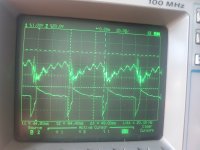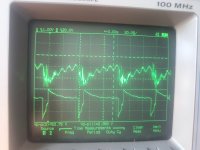Hi, one thing I recently discovered about my Vox Escort Bass was that R20, which should be 22 Ohm on the schematic, after the two diodes and before the base of TR3, basically a bare wire (I.e. no resistance) on the PCB. It looked like that was factory installed. My amp was clipping after notes were played, almost a “after-note distortion”. Replacing the wire with the correct resistor appears to have solved my problem. It sounds like your problem may have a different source but it’s worth checking this, just in case. You could also try an oscilloscope or audio probe to follow the signal and help isolate the problem. Hope this is useful and good luck!
Hi, yes that's the bias resistor. On mine 39R is originally. I tried to increase this (as the amp had very little idle current) as well as decrease and use third diode. I'm becomig to blame the CDILs, but still I don't understand why I can't se no signal on the TR6 base with scope. I think the feedback spreads the issue pretty everywhere in the circuit, so hard to tell where the problem really lies. Well it seemed to be related to the loading, so maybe those power transistors are really bad somehow (again weird, I measured them, but not at that voltage). I'll try to change them.
There too, but I think that's because of upper pair. The 180° signal is just missing. Now I'm putting back former (non paired) transistors that weren't good, but at least it was making sound. We'll see.
Well, with those former transistors the thig indeed "somehow" work. I will measure if it can get close 80V PP, or at least somewhere to 60 - 70V, thus signalising that the PP action takes place. Now when I'm thinking about it, should I even measure some significant voltage at the TR6 base? If it's driven by current and the emitter is grounded, then probably not. Nevertheless, I really don't understand what was wrong with those CDILs. Damn transistors.
So the amp gives nice output but only to 40V P-P. Then severe limitation on positive wave occurs. Negative wave keeps raising in amplitude to the cutoff. I tried another pair of CDILs. And exact the same as before happened. I'll attach photos from the scope. Channel 1 is TR1 base, channel 2 is output. This happens with quite low input. Increasing the input shortens the period of the havoc on the output.
Attachments
Next I mounted random old Czechoslovakian KD607 and the amp again "somehow" amplifies, this time 45V p-p. Verdict: CDIL 2N3055 I bought are probably unsuitable for audio use. Very interesting fact is, when I measured them, the Hfe raised with current. For example Hfe of 83 at 500mA vs 104 at 3A. Same transistor. Just weird. Maybe tempco played role there but as far as I remember I tested them warm and didn't let them go very hot. I hoped they will be ok, as I bought them from quite reputable seller. Well, maybe I'll build some regulators with them.
Last edited:
So, for those who maybe are interested. Amp is finally quite OK.
So that's it. Wasn't too nice, wasn't scientific, bud now I have the hope that client will be happy. And I'm happy that the thing will go away for good.
- there was added a nasty attempt at capacitance multiplier for OP amp supply. I don't know who did that, but PNP transistor on positive rail connected way around isn't promising. It hummed anyway. I returned it to the original state. With fresh capacitors (and just 220uF on C26) there is 15mV RMS of 100Hz hum at the output. Practically inaudible. No shielded cables, no added shielding whatsoever.
- those 2N3055 from CDIL were hellish. Kept my brain boiling for a week. Finally I used those KD607 transistors. There was no time for attempt to doing it clean, so I just found positions for them where the combination just worked better and rolled some drivers (in the end the matched PNP-NPN pair was by far the best). It's not hi-fi, after all. Idle current is set very low, about 15mA. Still it asked for increasing the R20 to 56R. I'm able to get close to 50W at 8R with slight clipping (and good deal of distortion) now. Another crime against humanity from me was setting the center voltage to 37V. Just got more clean power in given circumstances. Don't gonna solve the question "why", at least for now. Maybe that's the reason for mysterious "preset" name of the trimmer. I noticed that you can quite dramatically change clipping behavior with this element. Clipping at the upper half-wave sounds drastically different to the clipping at the lower half-wave.
So that's it. Wasn't too nice, wasn't scientific, bud now I have the hope that client will be happy. And I'm happy that the thing will go away for good.
Last edited:
- Home
- Live Sound
- Instruments and Amps
- Losing my VOX

